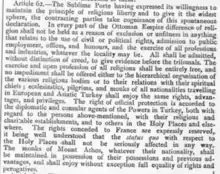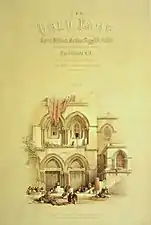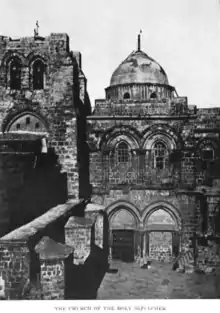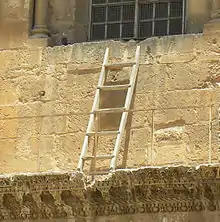Status Quo (Jerusalem and Bethlehem)
The Status Quo (Hebrew: סטטוס קוו, Arabic: الوضع الراهن) is an understanding among religious communities with respect to nine shared religious sites in Jerusalem and Bethlehem.[1] Other Holy Places in Israel and Palestine were not deemed subject to the Status Quo because the authorities of one religion or of one community within a religion are in recognized or effective possession.[2]

The status quo stemmed from a firman (decree) of Ottoman sultan Osman III in 1757[3] [4] that preserved the division of ownership and responsibilities of various Christian holy places. Further firmans issued in 1852 and 1853 affirmed that no changes could be made without consensus from all six Christian communities;[lower-alpha 1][5][6] these firmans received international recognition in Article 9 of the Treaty of Paris (1856).[7] The term "status quo" was first used in regards to the Holy Places in the Treaty of Berlin (1878).[7]
The 1929 summary prepared by L. G. A. Cust, The Status Quo in the Holy Places, became the standard text on the subject,[8] and the details were further formalized in the 1949 United Nations Conciliation Commission after the 1947–1949 Palestine war.
History

"The rights conceded to France are expressly reserved, it being well understood that the status quo with respect to the Holy Places shall not be seriously affected in any way."
Controlled by the Roman Empire and then, following its division, by the Eastern Roman (Byzantine) Empire, these eastern sites first became a point of contention in the centuries following 1054, when the Roman Catholic Church and Eastern Orthodoxy separated. Since the sites had been administered by the eastern church hierarchy they remained Orthodox. Following the seizure of the Holy Land by knights from the West in the First Crusade some sites passed from the Orthodox church to the Catholic church in the 12th century, although local christians remained then (as now) predominantly Orthodox. With the defeat of the crusader states and the rise of the Ottoman Empire, control of the sites oscillated between the Catholic (Latin) and the Orthodox (Greek) churches, depending upon which could obtain a favorable firman from the Ottoman "Sublime Porte" at a particular time, often through outright bribery. Violent clashes were not uncommon. There was no agreement about this question, although it was discussed at the negotiations to the Treaty of Karlowitz in 1699.[9]
In the Holy Week of 1757 there were important disturbances[10] in the Temple and, weary of the squabbling, the "Porte" issued a firman that divided the church among the claimants, giving the lion's share to the Greek Orthodox church. In the years preceding the Crimean War, Napoleon III of France pressured the Sultan to invalidate the 1757 status quo in favor of the Catholic church, leading in part to Nicholas I of Russia declaring war (Crimean War) in favor of the Orthodox church's rights. This resulted in 1852 and 1853 firmans (decrees) by Sultan Abdülmecid I which received international recognition in Article 9 of the Treaty of Paris (1856) leaving the status quo intact. The existing territorial division was solidified amongst the communities,[5][11] the treaty stating that "The actual status quo will be maintained and the Jerusalem shrines, whether owned in common or exclusively by the Greek, Latin, and Armenian communities, will all remain forever in their present state." Despite this declaration, there are no unanimous terms defining the status quo, sometimes causing contradictory differences of opinion.[12]
Despite the arguments over who would control what aspects of these sites, the Status Quo has remained largely intact from the 18th century to the present.
The term "status quo" was first used in regards to the Holy Places in Article 62 of the Treaty of Berlin (1878).[7][lower-alpha 2] A summary of the Status Quo prepared by L. G. A. Cust, a civil servant of the British Mandate, The Status Quo in the Holy Places, quickly became the standard text on the subject.[8][7]
Sites

According to the United Nations Conciliation Commission, the Status Quo applies to nine sites in Jerusalem and Bethlehem,[1] which Cust separates into three categories:
Disputed between Christian denominations
- The Church of the Holy Sepulchre and its dependencies, Jerusalem
- The Deir es-Sultan, on top of the Church of the Holy Sepulchre, Jerusalem
- The Tomb of the Virgin Mary, Jerusalem
- The Church of the Nativity, Bethlehem
- The Chapel of the Milk Grotto, Bethlehem (no records exist)[13]
- The Chapel of the Shepherd's Field, Bethlehem (no records exist)[13]
Disputed between Christian and Islamic denominations
- The Chapel of the Ascension, Jerusalem
Disputed between Jewish and Islamic denominations
- The Western Wall, Jerusalem[8]
- Rachel's Tomb, Bethlehem[8]
'Immovable ladder'
The so-called immovable ladder[lower-alpha 3] under the window of the Church of the Holy Sepulchre, made of Lebanon cedar wood, was in place by 1728 and has remained there ever since the 1757 status quo was established, aside from being temporarily moved twice. The ladder is referred to as immovable due to the agreement of the Status Quo that no cleric of the six ecumenical Christian orders[lower-alpha 1] may move, rearrange, or alter any property without the consent of the other five orders.
According to various accounts, the ladder once belonged to a mason who was doing restoration work in the Church of the Holy Sepulchre. Jerome Murphy-O'Connor states that "the ladder was first introduced at a time when the Ottomans taxed Christian clergy every time they left and entered the Holy Sepulchre." The Catholics adapted by setting up quarters inside the church.[6] O'Connor continues:
The window, ladder and ledge all belong to the Armenians. The ledge served as a balcony for the Armenian clergy resident in the Holy Sepulchre, and they reached it via the ladder. It was their only opportunity to get fresh air and sunshine. At one stage, apparently, they also grew fresh vegetables on the ledge.[6][lower-alpha 4]
The earliest record of the ladder is in a 1728 engraving by Elzearius Horn. In 1757, the same year the Status Quo was introduced, Ottoman sultan Abdul Hamid I mentioned the ladder in a firman,[15] and because everything was to be left “as it was” according to the royal decree, the ladder had to stay as it was too. An 1842 lithograph by David Roberts also shows the ladder in place.[16] The earliest photograph showing the ladder dates from the 1850s.[17] By the end of the 19th century, the ladder was being used to bring food to Armenian monks imprisoned by the Turks.[18] Turkish accounts mention the ladder being used by Armenian monks to clean the windows above the ledge.[19][20][21] The Byzantine cornice the ladder rests on has been used by the public during festivals.[22]
During his pilgrimage to the Holy Land in 1964, Pope Paul VI described the ladder as a visible symbol of Christian division.[23] In 1997, the ladder was supposedly pulled in through the window and hidden behind an altar by a Protestant Christian intending "to make a point of the silliness of the argument over whose ledge it is." It was returned to the ledge weeks later, and a grate was installed in the window.[6] In 2009, the ladder was placed against the left window for a short period before being moved back again.[24]
 1728 engraving showing the ladder
1728 engraving showing the ladder The ladder on the front page of the 1842-49 The Holy Land, Syria, Idumea, Arabia, Egypt, and Nubia
The ladder on the front page of the 1842-49 The Holy Land, Syria, Idumea, Arabia, Egypt, and Nubia Church of the Holy Sepulchre in 1885. The immovable ladder is visible below the upper-right window. (A different ladder leans against the dome.)
Church of the Holy Sepulchre in 1885. The immovable ladder is visible below the upper-right window. (A different ladder leans against the dome.) The immovable ladder, 2011
The immovable ladder, 2011
See also
- Church of the Holy Sepulchre § Status Quo
- Church of the Nativity § Property and administration
- David's Tomb, not subject to the status quo, but of its own Muslim waqf
- Simultaneum
- Status quo (Israel)
- Temple Mount entry restrictions
References
Footnotes
- The Roman Catholics, Greek Orthodox, Armenian, Syriac Orthodox, Coptic Christians and Ethiopians
- "The rights conceded to France are expressly reserved, it being well understood that the status quo with respect to the Holy Places shall not be seriously affected in any way."
- Hebrew: סולם הסטטוס קוו, romanized: sulam ha-status kvo, lit. 'the status quo ladder'; Arabic: السُّلَّمُ الثَّابِتُ, romanized: as-sullamu ṯ-ṯābitu, lit. 'the stationary ladder'
- "... the ladder leads to a balcony where the Armenian superior used to drink coffee with his friends and tend his flower garden; it is there so that the balcony can be cleaned."[14]
Citations
- UN Conciliation Commission 1949, p. 7.
- UN Conciliation Commission 1949, p. 7a: "As for example the Cenacle which, though a Christian Holy Place, has been in Moslem hands since the middle of the 16th century. The position that Christians do not in effect enjoy the right to hold services there is uncontested."
- Dumper, Michael; Stanley, Bruce E., eds. (2007). Cities of the Middle East and North Africa: A Historical Encyclopedia. ABC-CLIO. p. 209. ISBN 9781576079195.
- It is likely that this Decree was issued as a result of major disturbances that occurred in the Church of the Holy Sepulchre in 1757.
- Morio, Eva Maurer. "What does Status Quo stand for?". Latin Patriarchate of Jerusalem. Archived from the original on 13 June 2018. Retrieved 16 April 2019.
- Lancaster, James E. (2015). "The Church and the Ladder: Frozen in Time". CoastDaylight.com. Retrieved 16 April 2019.
- Lapîdôt, Rût; Hirsch, Moshe (19 May 1994). The Jerusalem Question and Its Resolution: Selected Documents. Martinus Nijhoff Publishers. p. 20. ISBN 0-7923-2893-0.
- Breger, Marshall J.; Reiter, Yitzhak; Hammer, Leonard (16 December 2009). Holy Places in the Israeli-Palestinian Conflict: Confrontation and Co-existence. Routledge. p. 24. ISBN 978-1-135-26812-1.
- Mailáth, János Nepomuk Jozsef (1848). Geschichte der europäischen Staaten, Geschichte des östreichischen Kaiserstaates [History of the European states, history of Austrian Imperial State]. 4. Hamburg: F. Perthes. p. 262.
- Basilica of the Holy Sepulchre in Jerusalem, 1757.
- Ḏḥwty (27 January 2018). "The Immovable Ladder: Bizarre Feud Prevents Ordinary Ladder Being Moved for 3 Centuries". Ancient Origins. Retrieved 8 May 2019.
- Cohen, Raymond (May 2009). "The Church of the Holy Sepulchre: A Work in Progress". The Bible and Interpretation. Retrieved 28 December 2018.
- Cust 1929: "The Grotto of the Milk and the Shepherd's Field near Bethlehem are also in general subject to the Status Quo, but in this connexion there is nothing on record concerning these two sites."
- Simon Sebag Montefiore (2012) [2011]. Jerusalem: The Biography. Vintage. p. 517n. ISBN 978-0307280503.
- "Greek Orthodox". See the Holy Land. 2017. Retrieved 3 March 2019.
- "Entrance to the holy sepulchre; title page, vol. 1". Library of Congress. Retrieved 11 May 2019.
- Günther Simmermacher. The Holy Land Trek: A Pilgrim's Guide. Southern Cross Books, Cape Town. p. 194–5. ISBN 978-0-9921817-0-3.
- Bar−Am, Aviva (1999). Beyond the Walls: Churches of Jerusalem. Ahva Press. p. 56.
- Kıyamet Kilisesi'nde restorasyon tamamlandı (Turkish)TRTHaber. Posted 23 March 2017.
- KIYAMET (KEMAMET) KLİSESİ (Turkish) FATIH KURTOGLU. Posted 26 November 2018.
- Kıyamet merdiveni (Turkish) YeniŞafak. 22 February 2017.
- Cust 1929, p. 17: "Above the doorway runs a classical cornice, a relic of the Byzantine buildings. This is reached from the windows of the Armenian Chapel of St. John, and this Community has the use thereof on the occasion of the festival ceremonies that take place in the Courtyard. ... [The cornice is] in a damaged condition and the whole facade is badly weather-beaten and requires expert attention."
- Günther Simmermacher. The Holy Land Trek: A Pilgrim's Guide. Southern Cross Books, Cape Town. p. 196. ISBN 978-0-9921817-0-3.
- Herman, Danny (10 June 2009). "Who moved thy ladder? (2010)". Private Tour Guide Israel - Danny the Digger. Retrieved 8 May 2019.
Sources
- UN Conciliation Commission (1949). United Nations Conciliation Commission for Palestine Working Paper on the Holy Places.
- Cust, L. G. A. (1929). The Status Quo in the Holy Places. H.M.S.O. for the High Commissioner of the Government of Palestine.
- Marlen Eordegian (2003), "British and Israeli Maintenance of the Status Quo in the Holy Places of Christendom", International Journal of Middle East Studies, Vol. 35, No. 2 (May, 2003), pp. 307–328
External links
- L. G. A. Cust's 1929 summary of the Status Quo history and regulations, with plans and photos
- Custody of the Holy Land, Status Quo – a short overview
- Aviva and Shmuel Bar-Am, "1,000 years of rivalry – and a little bit of harmony – at the Church of the Holy Sepulcher", in Times of Israel, 7 September 2012
